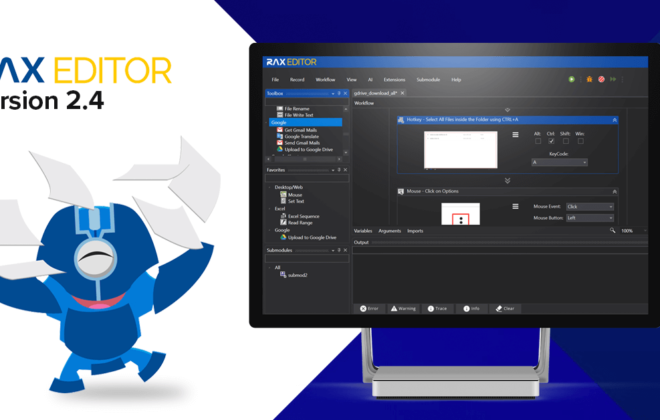Why Document Data Extraction is a Wise Automation Investment for Businesses
There’s no arguing that artificial intelligence (AI) is among the greatest discoveries by humans. With this particular technology anchored on many things including machine learning, what’s even more exciting are the possibilities it can bring to realize automation anywhere in the future. This poses a great help not just in the day-to-day lives of digital savvy consumers but more so for businesses embracing digital transformation.
The advancements in AI led to many things, among these is the prevalence of robotic process automation or RPA. Up to now, there exists a misconception that RPA will replace humans in the workplace in the long run but companies like RAX continue to educate business owners and stakeholders through their offered tools and software.
RAX EDITOR, one of the premiere automation solutions developed by RAX, is designed to eliminate repetitive manual labor in the workplace to promote a more seamless and efficient workload management. There are many layers of RAX EDITOR consisting of automation functions targeted to solve the common grievances encountered by businesses in their daily operations. In this blog, we’re putting the spotlight on one of the features RAX continuously enhances — Document Data Extraction using AI.
Similar to the Optical Character Recognition (OCR) feature of RAX EDITOR, its intelligent data extraction function also aims to free employees from the tedious manual typing and inputting of data. But unlike the former that simply converts images to texts, the latter does this in a more extensive way by learning words and patterns from scanned documents and attaching meanings to it through AI.
For example, an employee uses the Document Data Extraction tool with AI of RAX EDITOR on sales receipts. RAX EDITOR will scan the paper invoice and input the data automatically on the system in a shorter time. The Document Data Extraction function of RAX EDITOR will be able to identify the details found in the receipts like customer names and addresses, dates of transactions, paid amounts and remaining balances, and such. Through AI, data extracted will also be grouped into respective categories providing easier filing of information for a more convenient and faster access for future use.
“Similar to other automation features of RAX, the Document Data Extraction Tool would significantly reduce the time and human resources required for this specific task,” said Patrick Victoria, one of the developers of RAX.
“This would mean that the time and effort allocated by a business for this task could be allocated elsewhere which would significantly improve productivity and profitability,” he added.
The Document Data Extraction function of RAX EDITOR is useful for organizations who are gradually taking the steps towards digitization and automation. While these businesses have yet to completely discard having customers and employees fill out papers to get information for some aspects of the operations, automation comes in how the data collected is processed onboard their respective systems.
Watch how to extract data from Excel:
It’s likewise a wise investment for businesses in various industries who have grown familiar with digital transformation as this tool will drive operations efficiency more and will help in allocating manpower to more essential responsibilities. This in turn results in effective cost-cutting.
Information precision and accuracy also comes into play when it comes to data extraction with AI. RAX takes pride in this as from the initial tests conducted for the Document Data Extraction tool of RAX EDITOR, it successfully recorded 90% of correct data. This is expected to increase as the RAX team of developers and software engineers and specialists commit to enhance its accuracy.
Experience automation in your workplace now. Learn about Document Data Extraction and other windows of technological opportunities for your businesses through RAX EDITOR.





